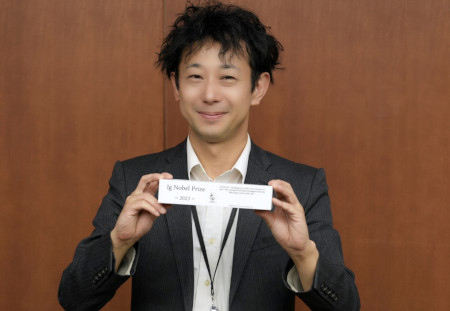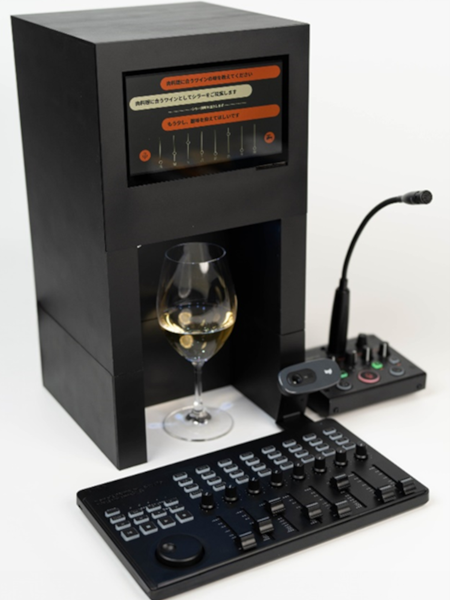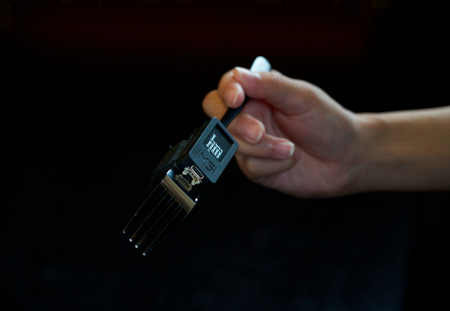[Press Release] Professor MIYASHITA Homei, School of Interdisciplinary Mathematical Sciences at Meiji University and the other received the Ig Nobel Prize in Nutrition
Sep. 15, 2023
Professor MIYASHITA Homei, School of Interdisciplinary Mathematical Sciences at Meiji University, and Project Associate Professor NAKAMURA Hiromi at the University of Tokyo (a master’s degree student at Meiji University at the time of the publication of the winning paper), have been awarded the Ig Nobel Prize in Nutrition.

I am very honored to receive this award. Although the award-winning paper was written 13 years ago, electric taste and taste media technologies have since been developed in many directions and implemented in society. I would like to continue to promote my research, as I see this award as expectations for such expansion and the future.

TTTV3, the latest model of TTTV *7

*1 Professor Homei Miyashita and others receive Lasting Impact Award for Augmented Humans
https://doi.org/10.1145/1959826.1959860
*2 Research on electric salt
Meiji University Press Release on April 11, 2022
A World First! Research Confirms Perceived Taste Change Via Electric Stimulation, Leading to Development of ‘Taste-Adjusting Chopsticks.’ Research confirms salty taste enhanced by approximately 1.5 times by subjects. A major step toward making low-sodium food tastier to aid in maintaining low-sodium diets. Electrically-stimulating chopsticks under development.
https://www.meiji.ac.jp/cip/english/news/2022/t4q24j0000006ezt.html
Meiji University Press Release on September 7, 2022
Spoon and Bowl that enhance the salty taste of low-sodium food by approximately 1.5 times via stimulation. Developed a unique current waveform that enhances the saltiness of low-sodium foods by approximately 1.5 times. Spoon and bowl-shaped “Electric Salt” devices with this current waveform have been developed. Joint demonstration experiment with two companies proposing healthy eating started in September. Aiming to launch the device in Japan in 2023.
https://www.meiji.ac.jp/cip/english/news/2022/r63u7s00000008bt.html
*3 Research on changing the taste of white wine to that of red wine
Kim Minji, Shuto Murakami, and Homei Miyashita. Reproduction of wine tastes using TTTV3. Entertainment Computing 2023 Proceedings, Vol.2023, pp.298-301, 2023.
https://youtu.be/oQpyxE3IUe8
*4 Research on changing cacao to taste like (higher quality) cacao from different production areas
Yuki Hou, Miku Fukaike, Nobuhito Kasahara, Shuto Murakami, Takegi Yoshimoto, Yoshiki Minato, Ryuto Tomihari, Kurata Miyashita, Takeharu Kawata, and Homei Miyashita. Method to quantify taste differences of cacao by production area and reproduce them with pure substances. Entertainment Computing Symposium Proceedings, Vol.2023, pp.390-393, 2023.
https://youtu.be/s8HxRz7KCz0
*5 Research to safely experience the taste of poisonous mushrooms
Homei Miyashita. 2022. Virtual eating experience of poisonous mushrooms using TTTV2. In Proceedings of the 28th ACM Symposium on Virtual Reality Software and Technology (VRST '22). Association for Computing Machinery, New York, NY, USA, Article 81, 1–2.
https://doi.org/10.1145/3562939.3565668
*6 Research to enable people with shellfish allergies to safely enjoy the taste of crab
Homei Miyashita. 2022. TTTV2 makes it possible for people with shellfish allergies to still enjoy the taste of crab virtually. In Proceedings of the 28th ACM Symposium on Virtual Reality Software and Technology (VRST '22). Association for Computing Machinery, New York, NY, USA, Article 79, 1–2.
https://doi.org/10.1145/3562939.3565669
*7 Research presentation on TTTV3
Meiji University Press Release on August 31, 2023
MIYASHITA Homei Laboratory of the School of Interdisciplinary Mathematical Sciences, Meiji University announces “TTTV3,” a seasoning device that uses AI to estimate tastes and reproduce differences in production areas
https://www.meiji.ac.jp/cip/english/news/2023/odl2060000000dlw.html
*8 How to eat garlic without causing bad breath
Miku Fukaike, Homei Miyashita. 2023. How To Eat Garlic Without Causing Bad Breath. In Adjunct. Proceedings of the 36th annual ACM symposium on user interface software and technology (UIST ’23 Adjunct). Association for Computing Machinery, New York, NY, USA, 1-2. (To appear)
≪Japanese version≫
What ’s the Ig Nobel Prize?
The Ig Nobel Prize, which is a parody of the Nobel Prize, is awarded for “research that first makes people laugh, and then makes them think.” It was founded in 1991 and run by Marc Abrahams, editor of the scientific satirical journal “Annals of Improbable Research.” Like the Nobel Prize, there are multiple categories, and the winners are selected from among more than 5,000 studies and achievements each year. The presenters who hand out the Ig Nobel Prizes are Nobel Laureates. The award ceremony was held online on September 14, 2023 at 18:00 (US EST) and the award was presented by Peter Doherty, the 1996 Nobel Laureate in Physiology or Medicine.Award-winning research (paper)
The Ig Nobel Prize in Nutrition was awarded to Professor MIYASHITA Homei and Project Associate Professor NAKAMURA Hiromi, who was a master’s student at Meiji University at the time the paper was published, for their 2011 paper “Augmented Gustation using Electricity.” The paper was about a vision of augmenting the taste experience of food and drink by altering the taste of food and drink with straws, chopsticks, and forks that carry a weak electric current. The paper also received the Lasting Impact Award at Augmented Humans 2021, which is given to a paper that has been widely cited and has had a broad impact for 10 years after publication, in 2021.*1Comment from Professor MIYASHITA Homei

Professor MIYASHITA Homei holding the Ig Nobel Prize trophy
I am very honored to receive this award. Although the award-winning paper was written 13 years ago, electric taste and taste media technologies have since been developed in many directions and implemented in society. I would like to continue to promote my research, as I see this award as expectations for such expansion and the future.
Past research results of electric taste developed in Miyashita Laboratory
Professor MIYASHITA Homei has since promoted research on taste media technology. First, in collaboration with Kirin Holdings Company, Limited, he developed an electrical stimulation waveform that enhances the taste of low-sodium food. Furthermore, clinical tests conducted on people who are actually eating a low-sodium diet have confirmed the effect of enhancing the saltiness perceived when eating a low-sodium diet by a factor of about 1.5, and an “Electric Salt” device incorporating this technology is scheduled for release by Kirin Holdings Company, Limited.*2At the Miyashita Laboratory, research is progressing to create new "taste media" in addition to electric taste
Professor MIYASHITA Homei has products besides "Electric Taste" that won this award, also developed many other taste media technologies, such as “Taste the TV” (TTTV), which reproduces arbitrary tastes based on measurements from taste sensors, and has produced many research results, such as “changing the taste of white wine to that of red wine,”*3 “changing cacao to taste like (higher quality) cacao from different production areas,”*4 “safely experiencing the taste of poisonous mushrooms”*5 and “enabling people with shellfish allergies to safely enjoy the taste of crab,”*6 and many other research results*7 that have redefined the common sense of taste. Additionally, at an international conference to be held at the end of October, he plans to present “How to eat garlic without causing bad breath.”*8
TTTV3, the latest model of TTTV *7

A fork equipped with a device that produces a garlic scent *8
*1 Professor Homei Miyashita and others receive Lasting Impact Award for Augmented Humans
https://doi.org/10.1145/1959826.1959860
*2 Research on electric salt
Meiji University Press Release on April 11, 2022
A World First! Research Confirms Perceived Taste Change Via Electric Stimulation, Leading to Development of ‘Taste-Adjusting Chopsticks.’ Research confirms salty taste enhanced by approximately 1.5 times by subjects. A major step toward making low-sodium food tastier to aid in maintaining low-sodium diets. Electrically-stimulating chopsticks under development.
https://www.meiji.ac.jp/cip/english/news/2022/t4q24j0000006ezt.html
Meiji University Press Release on September 7, 2022
Spoon and Bowl that enhance the salty taste of low-sodium food by approximately 1.5 times via stimulation. Developed a unique current waveform that enhances the saltiness of low-sodium foods by approximately 1.5 times. Spoon and bowl-shaped “Electric Salt” devices with this current waveform have been developed. Joint demonstration experiment with two companies proposing healthy eating started in September. Aiming to launch the device in Japan in 2023.
https://www.meiji.ac.jp/cip/english/news/2022/r63u7s00000008bt.html
*3 Research on changing the taste of white wine to that of red wine
Kim Minji, Shuto Murakami, and Homei Miyashita. Reproduction of wine tastes using TTTV3. Entertainment Computing 2023 Proceedings, Vol.2023, pp.298-301, 2023.
https://youtu.be/oQpyxE3IUe8
*4 Research on changing cacao to taste like (higher quality) cacao from different production areas
Yuki Hou, Miku Fukaike, Nobuhito Kasahara, Shuto Murakami, Takegi Yoshimoto, Yoshiki Minato, Ryuto Tomihari, Kurata Miyashita, Takeharu Kawata, and Homei Miyashita. Method to quantify taste differences of cacao by production area and reproduce them with pure substances. Entertainment Computing Symposium Proceedings, Vol.2023, pp.390-393, 2023.
https://youtu.be/s8HxRz7KCz0
*5 Research to safely experience the taste of poisonous mushrooms
Homei Miyashita. 2022. Virtual eating experience of poisonous mushrooms using TTTV2. In Proceedings of the 28th ACM Symposium on Virtual Reality Software and Technology (VRST '22). Association for Computing Machinery, New York, NY, USA, Article 81, 1–2.
https://doi.org/10.1145/3562939.3565668
*6 Research to enable people with shellfish allergies to safely enjoy the taste of crab
Homei Miyashita. 2022. TTTV2 makes it possible for people with shellfish allergies to still enjoy the taste of crab virtually. In Proceedings of the 28th ACM Symposium on Virtual Reality Software and Technology (VRST '22). Association for Computing Machinery, New York, NY, USA, Article 79, 1–2.
https://doi.org/10.1145/3562939.3565669
*7 Research presentation on TTTV3
Meiji University Press Release on August 31, 2023
MIYASHITA Homei Laboratory of the School of Interdisciplinary Mathematical Sciences, Meiji University announces “TTTV3,” a seasoning device that uses AI to estimate tastes and reproduce differences in production areas
https://www.meiji.ac.jp/cip/english/news/2023/odl2060000000dlw.html
*8 How to eat garlic without causing bad breath
Miku Fukaike, Homei Miyashita. 2023. How To Eat Garlic Without Causing Bad Breath. In Adjunct. Proceedings of the 36th annual ACM symposium on user interface software and technology (UIST ’23 Adjunct). Association for Computing Machinery, New York, NY, USA, 1-2. (To appear)
≪Japanese version≫
Related links


